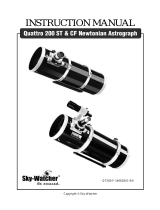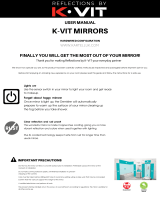
3
packaging to ensure the telescope stays intact during ship-
ping. Take a moment to inspect the telescope and all of its
parts.
Before proceeding with the instructions, refer to Figure
1 to familiarize yourself with some of the features and
components of the telescope.
Getting Started
The telescope arrives nearly fully assembled from the fac-
tory, with optics installed, in a single shipping box. The optics
were collimated at the factory, however you should check the
collimation prior to first use (see “Collimating the Optics”),
as it’s not uncommon for Newtonian optics to get bumped
slightly out of collimation in the delivery process. Likely only
a minor adjustment, if any, may be necessary.
Attaching the Telescope to a Mount
The f/3.9 Newtonian Astrographs each come with a pair of
hinged, felt-lined tube rings to hold the optical tube assembly
(OTA) on a mount. Each ring has a flat boss on opposing
sides. Both bosses have a ¼"-20 threaded hole in the center.
One tube ring has a piggyback camera adapter mounted on
one of the bosses, which can be used to mount a camera for
piggyback astrophotography. That adapter can be removed if
you wish to attach an optional dovetail plate to the top of the
tube rings for mounting a piggybacked guide scope.
The tube rings should be attached to a dovetail mounting
plate (sold separately) compatible with your mount’s equa-
torial head. Balancing the telescope is achieved by sliding
the dovetail mounting plate forward or backward within the
mount’s dovetail saddle. You can also move the telescope
forward or backward within the tube rings. To do so, loosen
the tube ring clamps slightly and slide the telescope tube
forward or backward as needed to reach optimum balance,
then retighten the clamps. Rotating the telescope to achieve
a comfortable eyepiece or camera angle is done in the same
fashion. Simply loosen the tube ring clamps just enough
to allow the optical tube to rotate within the tube rings.
Retighten the tube ring clamps securely once you have
reached the desired eyepiece or camera orientation.
2" Dual-Speed Crayford Focuser
The f/3.9 Newtonian Astrograph features an all-metal, 2"
dual-speed (11:1) Crayford-type focuser (Figure 2), which
allows very precise, fine focusing. A reinforcing plate inside
the optical tube just under the focuser provides added rigid-
ity, minimizing any “flexing” of the focuser housing on the
tube due to the weight and moment arm of the imaging
camera. If the drawtube slips under the weight of your imag-
ing system or heavy visual accessories, simply increase the
drawtube tension by gently tightening the drawtube tension-
ing thumbscrew as needed.
The smooth focus motion and fine-focus wheel allow preci-
sion adjustments for critical focusing of eyepieces and cam-
eras. Once focus is reached, you can lock the drawtube in
place by tightening the drawtube tensioning thumbscrew.
The focuser drawtube has a 2" collar on the end of it, with
two thumbscrews, for attachment of 2" accessories. The tele-
scope ships with a 1.25" eyepiece holder inserted into the 2"
collar.
The focuser drawtube has 38mm of travel.
Fine Focus
The dual-speed Crayford focuser features both coarse and
fine focusing wheels. The two large, silver-colored wheels
are for coarse focusing. The small black wheel next to the
right-hand large focus wheel allows ultra-precise focus
adjustment at a gear ratio of 11:1, meaning eleven turns
of the fine focus wheel equals one turn of the large focus
wheel.
Use the large focus wheels to achieve rough focus on your
target object, then use the fine focus wheel to home in on the
exact focus point. You will be amazed at the amount of detail
that careful fine focus adjustment brings in to view on targets
such as the lunar surface, planets, double stars, and other
celestial objects.
Focuser Reinforcing Plate
You’ll notice that on the inside of the optical tube directly under
the focuser is a steel reinforcing plate. This plate was added
to provide extra rigidity to the interface between the focuser
and tube, to minimize the possibility of flexure at that interface
due to the weight of the imaging camera and its positional
moment arm. Such flexure could cause undesirable distortion
in long-exposure astrophotographic images. This reinforcing
plate allows use of heavier cameras while minimizing the risk
of flexure between the focuser base and tube. It is a design
enhancement that other, similar scopes on the market do not
have.
1.25" Eyepiece holder Accessory lock
thumbscrews
2"
Accessory
collar
Coarse focus wheels
Drawtube
tensioning
thumbscrew
Eyepiece lock
thumbscrews
Figure 2. The 2" dual-speed (11:1) Crayford focuser
11:1
Fine
focus
wheel














